Vegetables are a delicious and nutrient-packed part of a healthy diet. Learning to cook them properly can mean the difference between firm, fiber-packed, nutrient-dense and vibrantly colored morsels of deliciousness on our plates and the grey, mushy, lifeless sludge that convinces most people that they don’t like vegetables.
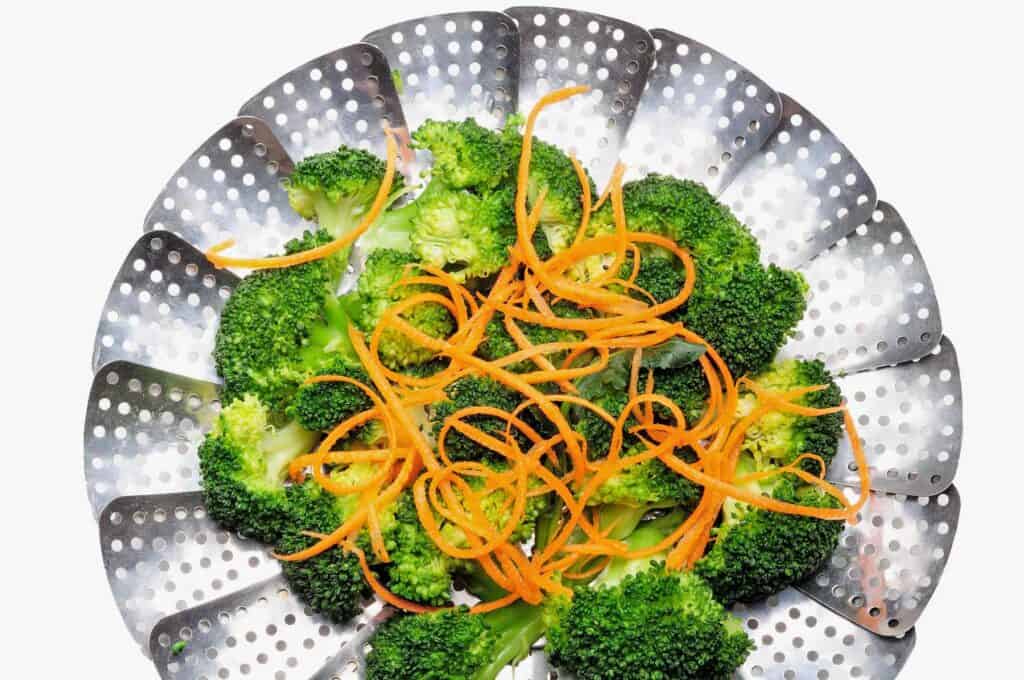
There are many excellent reasons to choose steaming vegetables over other cooking methods. And it’s a cooking method that is easy to master.
Benefits of steaming vegetables
First, steaming vegetables helps retain their gorgeous color, their nutritional fiber and their delicious flavor.
Steaming veggies is also quick and easy. Steam is much hotter than boiling liquid and results in fast cooking with less loss of nutrients. Plus, the clean-up is so simple.
Vitamins and minerals are retained, instead of draining away in the cooking liquid when you choose to steam vegetables.
And finally, with steaming, no extra fat or calories are added to the vegetables and your veggies soften making them easier to digest.
No steamer, no worries
Even though many of us may not own an official vegetable steamer, steaming vegetables is still a delicious possibility.
I’ll share three options for how to steam vegetables without a steamer. You can use tools you already have at home and the process will still be simple.
Start with the right vegetables
Whether you use them as a side dish or a meatless meal, knowing how to steam vegetables properly is critical to a successful dinner. Choosing vegetables that steam well is important, too. These veggies are perfect steamers.
- Leafy greens like spinach, chard or kale can all be steamed.
- Cabbage
- Brussels sprouts
- Cauliflower
- Broccoli
- Carrots
- Mushrooms
- Artichokes
- Zucchini and Yellow Squash
- Green beans
- Corn
- Peas
- Peppers
- New Potatoes
- Beets

Can I steam frozen vegetables?
Did you know that frozen vegetables can also be steamed successfully? I frequently steam frozen broccoli, cauliflower and carrots. Frozen corn, peas, and green beans also steam equally well.
Keep in mind that frozen vegetables have been blanched before freezing, so they may require a minute or two less cooking time than their fresh counterparts.
Preparing your vegetables for steaming
- Begin by properly cleaning, peeling and trimming your produce.
- Cut the vegetables into uniform sizes so they will steam evenly and in equal amounts of time.
- Think about the seasoning you want for your vegetables. Do you want to infuse them with flavor as they steam? Or, do you prefer to toss them in a sauce after steaming like these Green Beans with Garlic Butter Sauce?
Vegetable seasoning choices
Always toss your vegetables with salt before steaming them if you don’t plan to use any other seasoning. This will enhance the natural flavors of the vegetables you are cooking. But you can definitely get more creative with your seasoning choices, too.
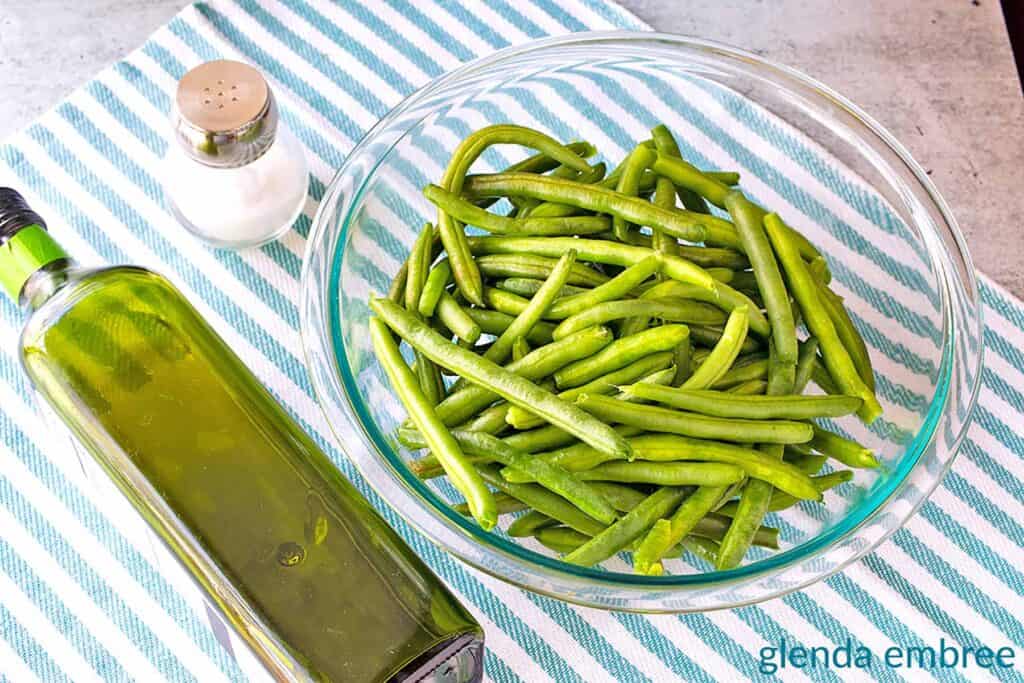
Toss your veggies in a bit of olive oil or avocado oil and some dried herbs before placing them in the pan. Parsley, basil, oregano, tarragon, thyme and rosemary are popular choices.
You can also add lemon slices, crushed garlic cloves or fresh herb leaves to the vegetables and toss to combine them before steaming.
I love to combine vegetables with avocado oil or melted butter mixed with my Homemade All Purpose Seasoning and some freshly minced garlic. Then I add them to the steam pot for a delectably seasoned veggie side dish.
Try tossing a pound of asparagus with a small amount of sesame oil mixed with soy sauce and some freshly grated ginger. Add to the pot and steam as usual.
The seasoning possibilities for dressing up steamed vegetables are only limited by your imagination. Get creative and you’ll find endless possibilities for amping up your side dish recipes.
Filled with appetizers, salads, sides, mains and desserts, Food Drink Life's cookbook will become your favorite!
- Easy and delicious recipes from a variety of top chefs and recipe developers.
- Bright, colorful pictures on every page.
- Printer-friendly recipes that you can download instantly to your device.
- Printable shopping list and a kitchen conversion sheet.
How to steam vegetables without a steamer
If you don’t have a pan with a fancy steamer basket insert, you don’t need to worry. Here are two easy methods to steam vegetables without a steamer.
Rolled foil, a plate and a pot with a lid
- Choose a pot with a tight-fitting lid and that will be large enough to accommodate a heat-proof plate or a round, 8-inch foil cake pan. Dutch ovens work well. There needs to be space between the walls of the pan and the plate or foil pan to allow steam to rise.
- Roll three balls of foil until they are golf ball size or slightly larger.
- Place the foil balls in the bottom of the pot and then add one inch of water to the bottom of the pan.
- Arrange the heat-proof plate or an 8-inch round foil cake pan over the foil balls, so that it rests in a fairly level position above the water line.
- Toss the vegetables with salt and/or any seasonings you have chosen.
- Add the vegetables to the plate or the foil cake pan.
- Bring the water to a boil.
- Cover the pot with its lid and reduce the heat to medium. The water should still boil and produce steam, but never actually touch the vegetables.
- Steam the vegetables to the desired doneness and serve them with the rest of your meal.
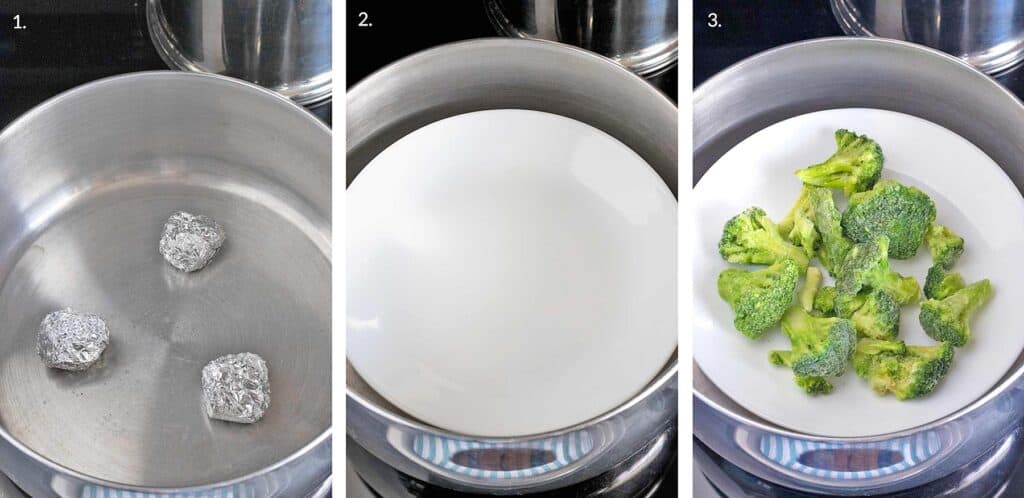
Use a metal colander or sieve that fits inside a pot with a lid
- Choose a colander that has legs or a base that raises the bottom of it up off the bottom of the pan. Alternatively, you can roll golf-ball-sized balls of foil to set it on and raise it above the water line.
- If using a sieve, make sure all the parts are heat-proof and that it will fit over the rim of your pan without the bottom of the sieve touching the bottom of your pan. Again, you want it to rest above the water line, so only steam is getting inside, not water.
- With either of these choices, it’s important that you will be able to close the lid tightly over the top of the pan. If steam is escaping it will take longer for the vegetables to cook.
- Place one inch of water in the bottom of the pan.
- Situate the sieve firmly over the pan’s rim and add the seasoned vegetables.
- Cover with a lid and cook for the recommended time.
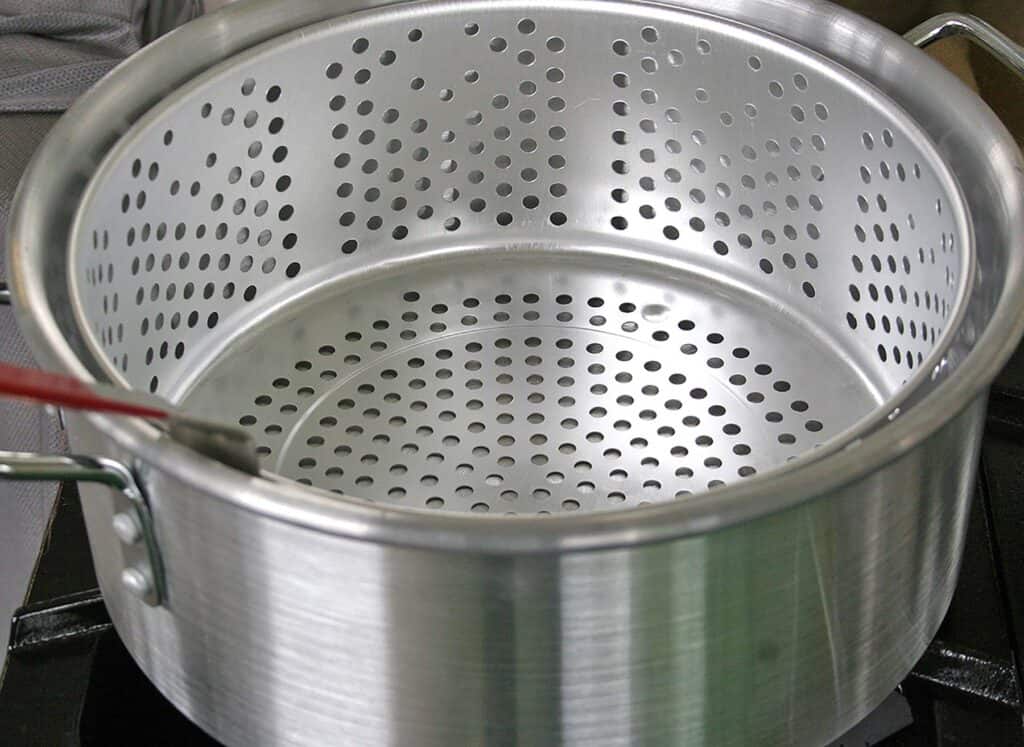
Steam-in-the-Bag Veggies
One final option is to buy vegetables meant to be steamed in their bag. Nowadays, frozen vegetables can be purchased from the freezer case and steamed right inside the bag they were purchased in.
I prefer to purchase frozen vegetables that can be steamed right in the bag they’re sold in. My favorite is Green Giant’s cauliflower rice, which is cooked right from frozen in only five minutes.
— Sara Nelson, Real Balanced
Steaming time and temperature
If you’ve ever been served mushy, colorless and flavorless vegetables you know exactly why timing is critical.
Your steamed vegetables can be vibrantly colored, tender-crisp and flavorful if they are cooked for the appropriate amount of time.
The correct time will depend on how tightly your pot is sealed and how well it holds steam. So, it can vary slightly from kitchen to kitchen. But, with practice, you will find the method and timing that is perfect for you.
These are some general cooking times to help get you started.
- Spinach, collards and other leafy greens will be steamed in just two to three minutes (and if you like spinach, try these Lebanese spinach pies).
- Asparagus takes about four to six minutes to be fork-tender and still brilliantly green and flavorful.
- Broccoli and cauliflower can be steamed in five to seven minutes, even if starting from frozen. If steaming from frozen, begin checking broccoli and cauliflower at the five-minute mark.
- Carrot, cut into quarter-inch slices or sticks, will steam in six to eight minutes. If starting with frozen use one to two minutes less cooking time.
- Zucchini and yellow squash, cut into quarter-inch thick rounds, should steam in four to five minutes.
- Peas can be steamed in two to four minutes, whether fresh or frozen.
- Corn takes three to five minutes to be steamed all the way through, whether fresh or frozen.
- Steam asparagus and green beans for three to five minutes.
- Beets, potatoes and harder root vegetables will need to steam at least 10 to 15 minutes.
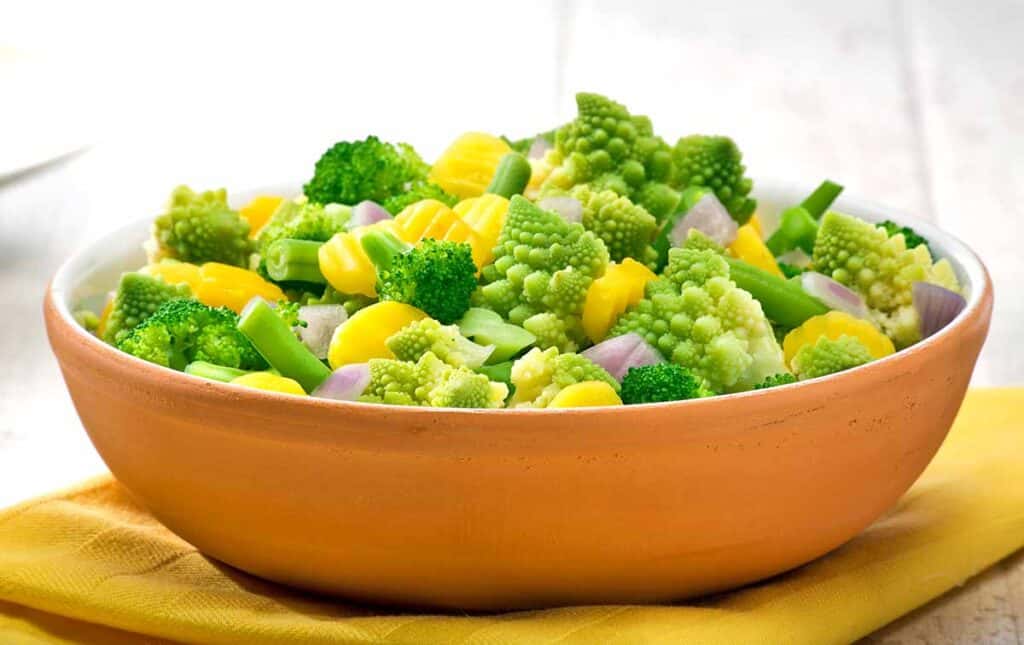
Testing for doneness
Different people prefer different levels of doneness when preparing vegetables. If you like your vegetables very soft, then longer cooking times will be required. If you like vegetables to be soft, but still retain a toothsome bite (tender-crisp), start with shorter cooking times.
When you are ready to check that the vegetables are cooked through, follow these steps and look for a few telltale signs.
- When the timer says your vegetables are finished grab a fork and a hot pad.
- Be careful to remove the lid of your pan by tipping the bottom of the lid away from you. This will direct the steam away from your face and hands as the pot is opened.
- The color of the vegetables should still be bright and vivid.
- Use a fork to pierce the vegetables you are steaming. The fork should slide into the veggies easily when they are done cooking. This is true even of more tender-crisp vegetables.
Enjoying gorgeous and flavorful steamed vegetables
Steamed vegetables are nutritious and have beautiful rich colors making them eye-appealing on the plate.
They cook quickly with little effort and the clean-up from steamed vegetables is simple.
Even if you don’t own a traditional vegetable steamer, you can successfully steam vegetables with simple tools you already have in your kitchen.
The possibilities for creative flavor combinations and seasonings are vast. Steamed vegetables definitely do not need to be boring.
Now, that you know how to steam vegetables without a steamer, you’ll be able to enjoy vibrant and flavorful vegetable dishes that add irresistible color to your plate and nutrition to your meals.
Glenda is the creator and recipe developer at Glenda Embree blog. She believes cooking from scratch doesn’t need to be complicated. She happily shares family favorite recipes and teaches readers how to make homemade food an easy and affordable option in their own kitchens.
